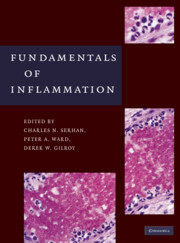Book contents
- Frontmatter
- Contents
- Contributors
- Preface
- PART I THE INFLAMMATORY RESPONSE – AN OVERVIEW
- PART II INDIVIDUAL CELL TYPES
- PART III CHEMICAL MEDIATORS
- PART IV IMMUNOPHARMACOLOGY
- PART V INFLAMMATORY DISEASES/HISTOLOGY
- PART VI ANIMAL MODELS OF INFLAMMATION
- 27 Models of Acute Inflammation – Air-Pouch, Peritonitis, and Ischemia-Reperfusion
- 28A Experimental Models of Glomerulonephritis
- 28B Glomerulonephritis and Ischemia Reperfusion Injury
- 29 Asthma
- 30 Animal Models of Rheumatoid Arthritis
- 31 Ocular Inflammation Models
- 32 Atherosclerosis in Experimental Animal Models
- 33 Oral Inflammation and Periodontitis
- 34 Pathogens and Inflammation
- Index
- References
30 - Animal Models of Rheumatoid Arthritis
from PART VI - ANIMAL MODELS OF INFLAMMATION
Published online by Cambridge University Press: 05 April 2014
- Frontmatter
- Contents
- Contributors
- Preface
- PART I THE INFLAMMATORY RESPONSE – AN OVERVIEW
- PART II INDIVIDUAL CELL TYPES
- PART III CHEMICAL MEDIATORS
- PART IV IMMUNOPHARMACOLOGY
- PART V INFLAMMATORY DISEASES/HISTOLOGY
- PART VI ANIMAL MODELS OF INFLAMMATION
- 27 Models of Acute Inflammation – Air-Pouch, Peritonitis, and Ischemia-Reperfusion
- 28A Experimental Models of Glomerulonephritis
- 28B Glomerulonephritis and Ischemia Reperfusion Injury
- 29 Asthma
- 30 Animal Models of Rheumatoid Arthritis
- 31 Ocular Inflammation Models
- 32 Atherosclerosis in Experimental Animal Models
- 33 Oral Inflammation and Periodontitis
- 34 Pathogens and Inflammation
- Index
- References
Summary
RHEUMATOID ARTHRITIS
Rheumatoid arthritis (RA) is an extremely painful, debilitating, and destructive inflammatory disease of diarthrodial joints. It affects between 0.5% and 1% of the world's population, with women having a threefold prevalence. Using traditional therapy, the majority will develop moderate disability at 2 years, with 40% being unable to work at 5 years. The disease has a high cost in pain, disability, and deformity. Morbidity is high, with a reduced lifespan. The advent of new treatment paradigms has meant that disability has been reduced, orthopedic surgeries have a much reduced rheumatoid joint replacement case-load, and whilst still severe, the aim of therapy is to preserve normal lifestyle and work patterns.
This is achieved by the use of low-dose methotrexate, leflunomide, or sulphasalazine, followed by biologic therapies, mainly anti-tumor necrosis factor (anti-TNF-α), anti-B cell (anti-CD20), recombinant human IL-1 receptor antagonist (rhIL-1ra), or anti-interleukin-6 (anti-IL-6). There remains a severe problem that despite these regimes a significant proportion (up to 40% for anti-TNF-α) do not respond. In addition, these treatments are expensive in their own right, and heavy on clinical resources for administration and monitoring. There is thus a continuing requirement for the development of improved therapeutics through drug discovery and further development of current therapeutics and their targets. A detailed understanding of the pathogenic mechanisms of RA are also required to fulfill these aims. Animal models of rheumatic disease continue to play a significant role in this process.
- Type
- Chapter
- Information
- Fundamentals of Inflammation , pp. 385 - 412Publisher: Cambridge University PressPrint publication year: 2010
References
- 2
- Cited by

